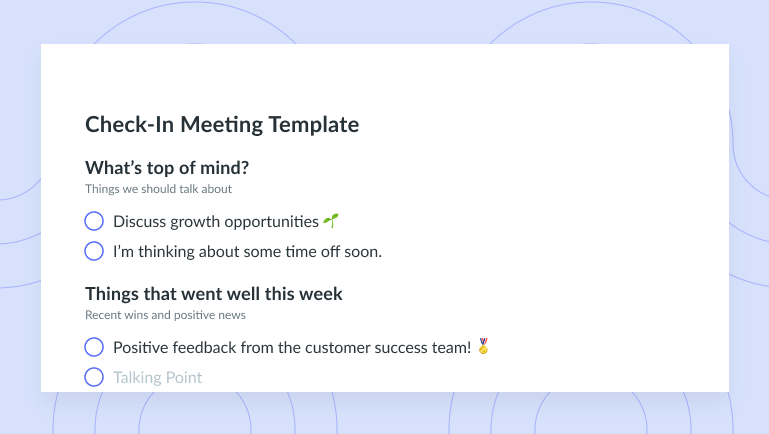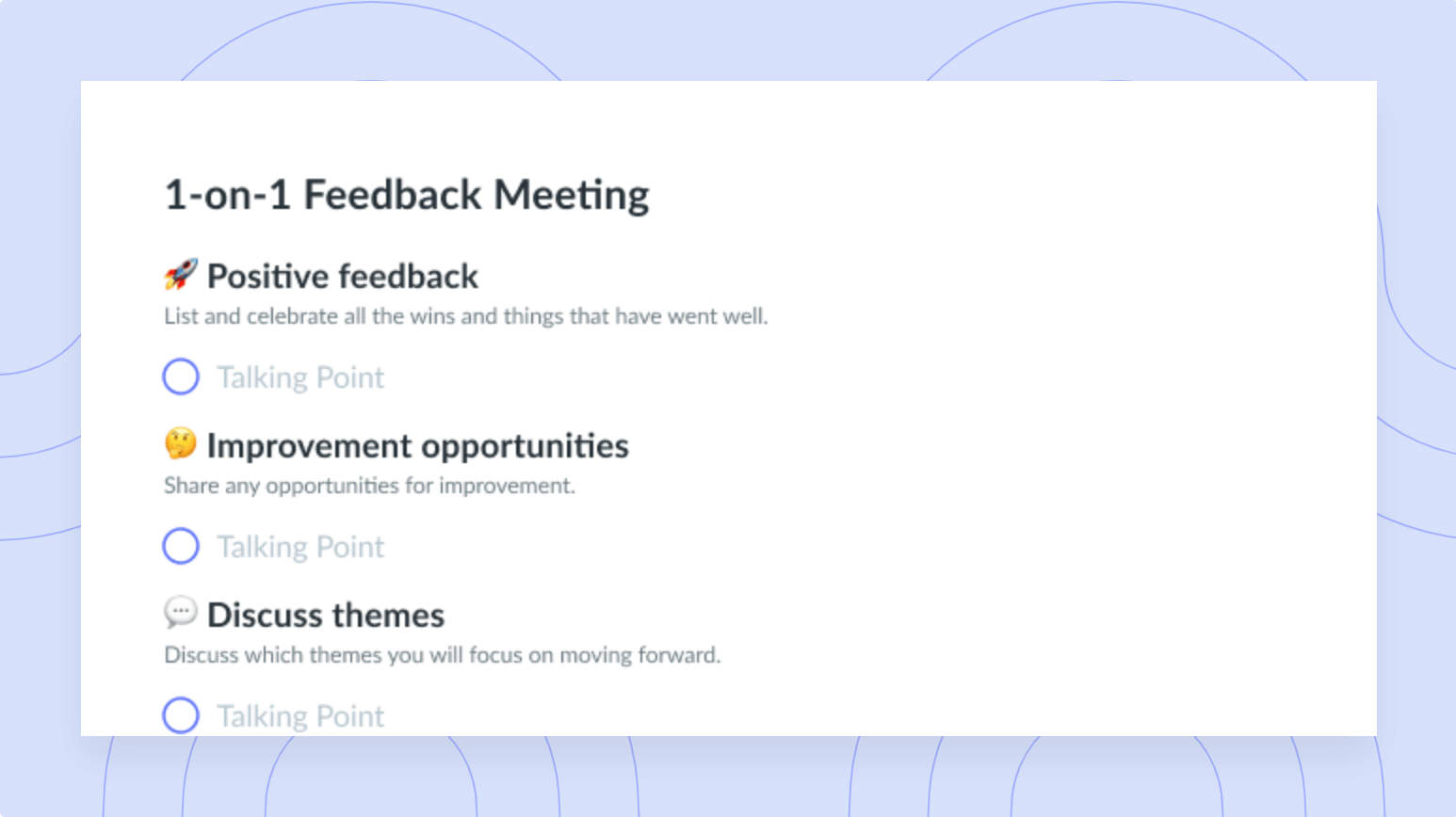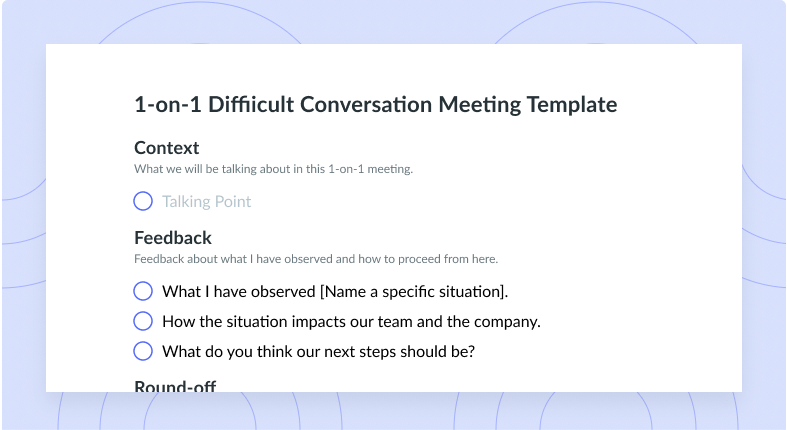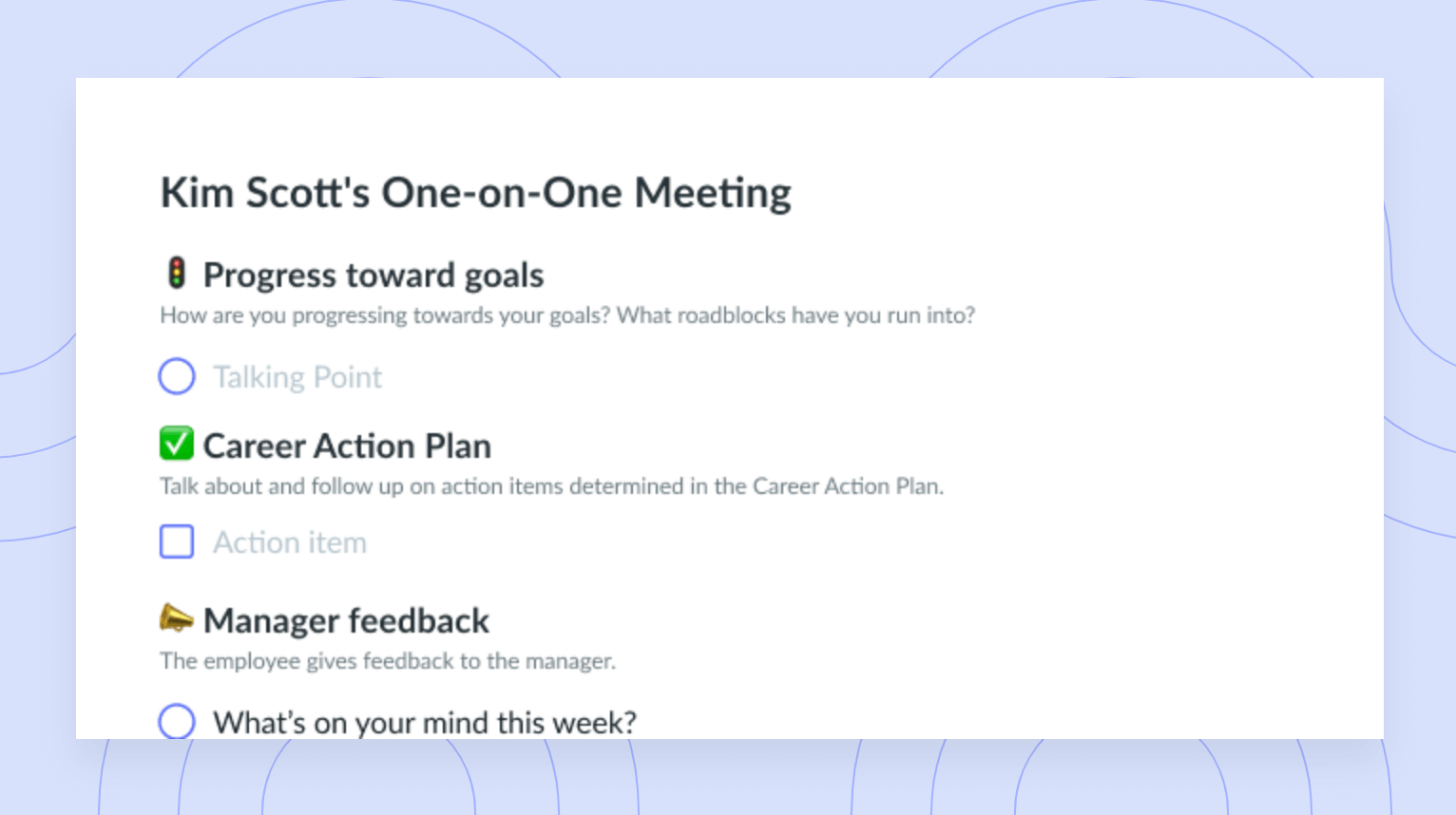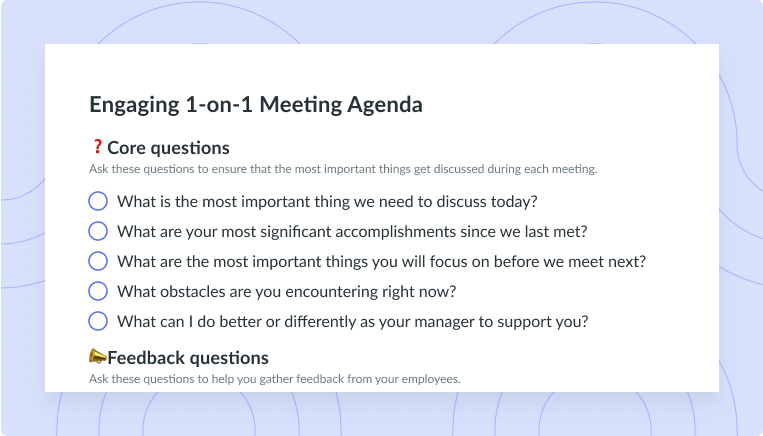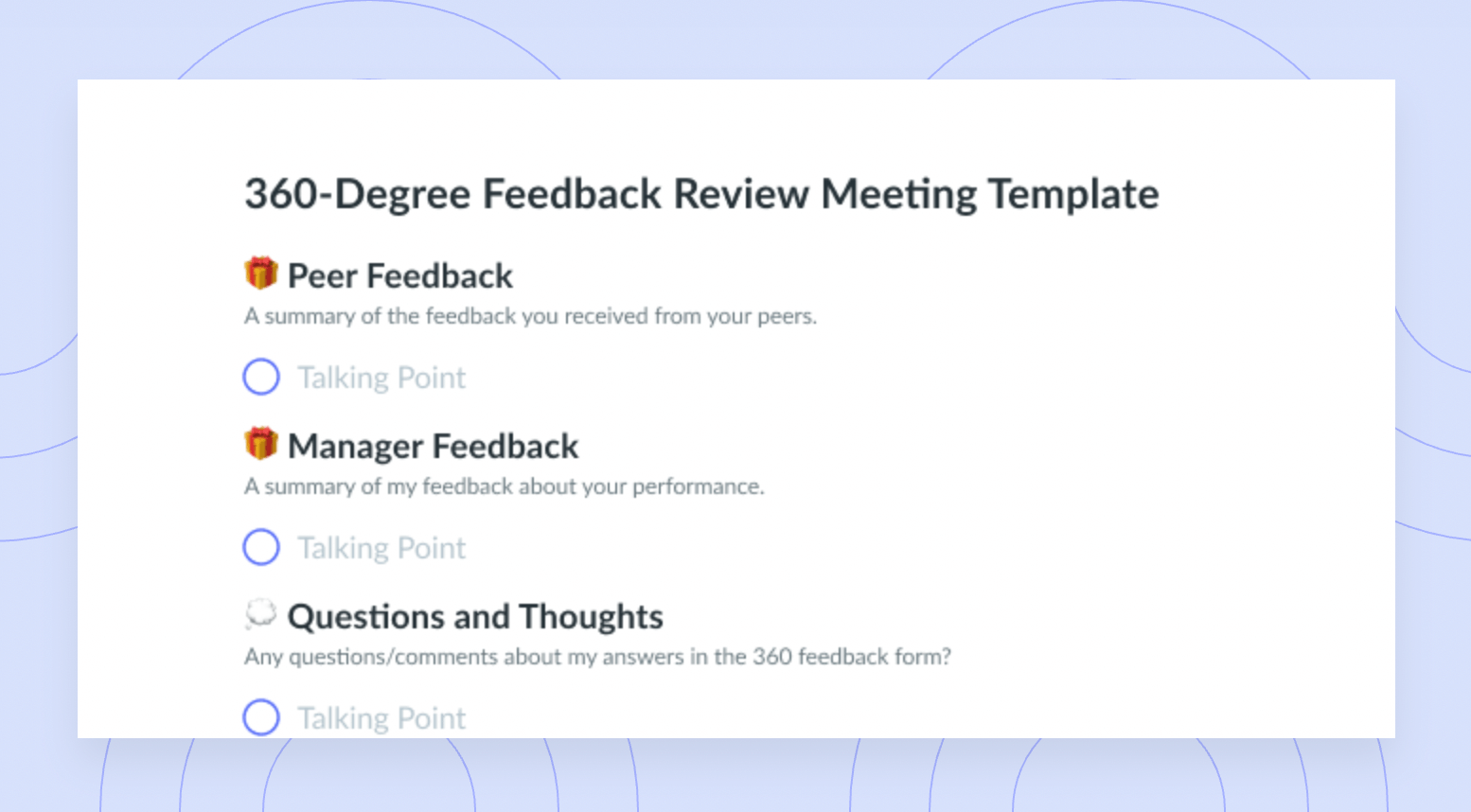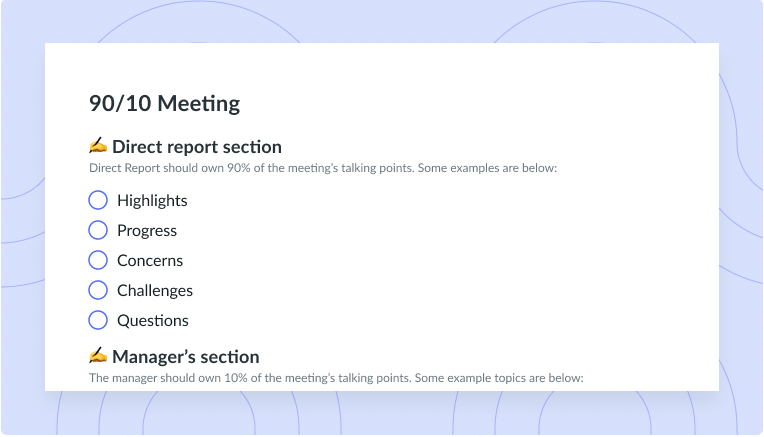A Managers Guide for Giving and Receiving Feedback
Advice from expert leaders on how to give employee feedback and receive feedback as a manager.
Feedback is a gift— one that can help you improve team results and relationships with your direct reports.
In fact, a study quoted in the book First, Break All The Rules says that the world’s best managers share three characteristics: they exchange feedback continuously, focus on employee strengths, and offer criticism in private—during one-on-one meetings.
At Fellow.app, we believe the best managers are those who offer feedback as work happens, and not only during cycles that dictate when feedback should be given.
If you agree with this statement and would like to learn how great managers give and receive feedback from their employees, you should definitely read this post:
- Why giving employee feedback matters
- How to give feedback as a manager
- Why receiving feedback is important
- How to receive feedback from employees
- What if you disagree with the feedback
Why giving feedback matters
Giving feedback—both when things are going well and when they aren’t— is one of the most important responsibilities of a manager.
Julie Zhuo (Facebook’s VP of Product Design), argues that every manager should set clear expectations with their direct reports and give specific feedback as regularly as possible, in order to help them grow:
“Mastering this skill means that you can knock down two of the biggest barriers preventing your reports from doing great work—unclear expectations and inadequate skills—so that they know exactly where to aim and how to hit the target,” says Zhuo in The Making of a Manager.
If you only have performance conversations during stated cycles (like annual performance reviews), you give employees the impression that you’re giving them feedback just because you have to.
On the other hand, when you provide weekly feedback or constructive comments as soon as you notice something your direct reports can improve, they’ll see you as someone who actually cares about their growth. Less like a manager, and more like a coach.
“Feedback is a gift. It costs time and effort to share, but when we have it, we’re better off. So let’s give it generously,” says Zhuo.
How to give feedback at work
Based on our research and interviews with management experts, we’ve outlined 6 specific steps to give feedback to your teammates:
1 Know your people
In The Manager’s Path, Camille Fournier argues that the first step to successfully giving continuous feedback is a basic understanding of your reports’ strengths and weaknesses. Ask yourself:
- What are my direct report’s goals?
- What are their strengths and weaknesses?
- At what level are they currently operating, and where might they need to improve to get to the next level?
“Good managers have a knack for identifying talents and helping people draw more out of their strengths,” says Fournier. “Yes, you’ll also want to look for weaknesses and areas of improvement, but if you spend most of your time trying to get people to correct weaknesses you’ll end up with a style that feels more like continuous criticism.”
Another important component of knowing your direct reports is understanding if it’s the right time to offer them feedback. Whenever you recognize an issue, make sure to always ask for permission:
- Would you mind if I gave you some feedback?
- Is this a good time to offer you some feedback?
2 Give feedback immediately
Talk about the things that don’t seem to be going well as you notice them. The best feedback is timely.
Did someone say “uuhmm” a lot during a presentation? Find some time to let them know your thoughts and offer some resources or advice. Did a team member make a mistake at work? Let them know during that week’s one-on-one meeting and not four months later, at a performance review.
“This also goes for getting praise. A great manager will notice some of the little things you’re doing well in your day-to-day, and recognize you for them,” says Camille Fournier.
Of course, there are times when you should wait to praise or criticize somebody. As Kim Scott argues in Radical Candor:
“Generally, if either you or the other person is hungry, angry or tired, or for some other reason not in a good frame of mind, it’s better to wait. However, this is the exception not the rule, and too often we use the exception as an excuse not to do what we know we should do.”
3 Praise in public, criticize in private
Remember the study of “great managers” that we mentioned at the beginning of this post? In First, Break All The Rules, Marcus Buckingham explains that one of the characteristics of great managers is that they give feedback in private, during one-on-one meetings:
“The purpose of feedback is to help each individual understand and build on his natural talents. You cannot do this in a group setting,” says Buckingham. “This sounds obvious (…) but it is surprising how many managers forget the importance of spending time alone with each of their people.”
If it’s time to give someone on your team constructive feedback because they did something that needs improvement, make sure to give them that piece of feedback in private and in person. Don’t send them an email or call them out at a team meeting. If your intention is to help that person grow, you should find a quiet space to offer your advice face-to-face.

Pro tip
Use a meeting management tool like Fellow to incorporate feedback into your day-to-day meetings and promote a culture of asking for feedback.

As Kim Scott argues in Radical Candor, giving feedback in person also helps you avoid misunderstandings:
“The clarity of your guidance gets measured at the other person’s ear, not at your own. That’s why it’s best to deliver guidance in person,” says Kim Scott.
On the other hand, praise can be shared publicly—as long as your report is comfortable with it. (If your direct report prefers private praise, make sure to respect that):
“Public criticism tends to trigger a defensive reaction and make it much harder for a person to accept they’ve made a mistake and to learn from it,” says Scott. “Public praise tends to lend more weight on the praise, and it encourages others to emulate whatever was great.”
4 Don’t personalize
Feedback should never be directed at the person, but at the action or habit they should work on.
For instance, if someone has been late to your team meetings several times, you must never say things such as “you’re irresponsible” or “you don’t care about other people’s time.” Instead, you can describe the specific events and the ways in which that person’s tardiness affected everyone else on the team.
As Kim Scott argues, radically candid criticism is about the work, not the person:
“There is a big difference between caring personally and personalizing when giving praise and criticism. Caring personally is good. Personalizing is bad,” says Scott.
If you’re still wondering how to make your feedback less “personal,” you can use what Lara Hogan calls the feedback equation:
- Observation: describe the who/what/when/where of the situation you’re referring to.
- Impact: describe how your employee’s action has affected you or others.
- Request or question: ask an open question at the end of delivering feedback. For example – “How could we come to a compromise going forward?”
“If you structure all of your feedback this way—not just big, important feedback, but even tiny little pieces of feedback that you might casually have throughout your day—you’ll find it’s really easy to give successful feedback that people will actually hear,” says Hogan.
5 Focus on the future
While the first part of your discussion may focus on the employee’s actions, the majority of time should be devoted to what Marcus Buckingham calls “the truly creative work” — which means, figuring out next steps and ways in which you could help:
“Great managers focus on the future: They want to discuss what could be rather than allowing the conversation to descend into recriminations and postmortems that lead nowhere,” says Buckingham.
If your goal is to be a helpful manager, telling people that they did something wrong is not enough. You should offer resources, ideas and guidance to help them accelerate their growth. Ask questions like “is there anything I can do to help you?” or “what are the next steps you’ll take to change this behaviour?” — focus more on the future, and less on what happened before.
“Ultimately, continuous feedback works best when you, as a manager, pair that feedback with coaching,” says Camille Fournier.
6 Record the feedback
The last important step you should take when giving employee feedback is recording all the information. This ensures that neither you nor your direct report will forget that you had this important conversation.
As Julie Zhuo argues in The Making of a Manager, recording feedback also empowers you to analyze emerging themes and behaviours:
“When you zoom out and look at many examples of task-specific feedback for a report, what themes emerge? Does he make decisions quickly or slowly? Is he a process wizard or an unconventional thinker? … By connecting the dots across multiple examples, you can help people understand how their unique interests, personalities, and habits affect their ability to have impact,” says Zhuo.
Why receiving feedback is important
Here’s one thing you might not have considered. Before giving any feedback to your employees, you should always ask for it first. Make it a habit to ask for feedback about your meetings, projects, and leadership style.
Asking employees for their feedback (and learning how to give and receive feedback properly) can help you:
- Normalize feedback and build a culture of continuous improvement
- Build trust with your direct reports
- Find ways to continuously improve as a leader
“There are several reasons why it makes sense to begin building a culture of Radical Candor by asking people to criticize you. First, it’s the best way to show that you are aware that you are often wrong, and that you want to hear about it when you are.”
– Kim Scott, author of Radical Candor
How to receive feedback from employees
Here are three things you should consider when receiving feedback from staff:
1 Acknowledge your weaknesses
One way to encourage your teammates to give you helpful feedback is letting them know about the things you normally struggle with and asking them to call you out on them. Here’s an example:
In a Harvard Business Review article, Ron Carucchi describes a manager who spoke for way too long whenever he felt anxious during meetings or presentations.
“One of the ways he worked to improve was to acknowledge to his team that he was aware he did it (which they greatly appreciated) and he asked them to simply hold up their hands when they felt he’d gone on too long,” says Carucchi. “Self-aware leaders know their triggers, and let others name them.”
Kim Scott gives a similar example in Radical Candor:
“My cofounder Russ once complained that I interrupted him. It was true; I am an inveterate interrupter,” says Scott. “So I said, ‘I know, it’s a problem. Can I ask you to help me stop interrupting?’ I pulled a fat, blue rubber band out of my drawer and put it around my wrist. I asked him to snap the rubber band every time I interrupted him. Russ thought it was funny, and I agreed.”
As Scott says in the book, the additional snapping did help her interrupt less. However, the most important part was that it sent a strong signal that she was taking action to apply her team’s feedback.
You don’t have to ask every employee to snap you with a rubber band. However, you can start by telling them what you want to improve. Letting your team know that you’re aware of your weaknesses makes you a more approachable boss. It not only makes you look more human, but also works as a good incentive to work continuously on your personal growth.
2 Ask specific questions
Put yourself in your employee’s shoes. If your manager asked you for feedback without being specific, it would be hard to come up with a response on the spot. This is why asking “do you have any feedback for me?” is great… but not enough.
In contrast, when you ask specific questions, you’ll not only help your direct reports come up with better answers but help yourself in areas where you know you need some improvement or growth.
For instance, you can start by asking yes/no questions to get straightforward answers from them. Some of the questions you can ask during your one-on-one meetings include:
- Am I giving you enough direction on projects and priorities?
- Do you feel comfortable raising issues and concerns with me?
- Do you think our team meetings are well organized?
- Do you think I give you enough feedback?
- Do you think I do a good job at communicating updates and changes with the team?
On the other hand, you can write a list of open-ended questions that you’d like to ask.
Open-ended questions are great to follow up on your employee’s yes/no answers. For example, if they said that they’d like more direction and support from you, you could ask questions such as:
- What’s one thing I can do to support you more?
- What’s something I could change about the way I assign projects and tasks?
- What’s something I can start doing to make it easier for us to work together?
- How can I help you be more productive and engaged at work?
Kim Scott argues that when you’re the boss, it’s awkward to ask your direct reports to tell you frankly what they think of your performance—and it’s even more awkward for them than it is for you.
This is why she adopted a ‘go-to question’ to kick things off. If you’re struggling to ask your direct reports for feedback, you can start by asking this too:
- Is there anything I could do or stop doing that would make it easier to work with me?
“If those words don’t fall easily off your tongue, find words that do,” says Scott. “Of course, you’re not really just looking for one thing: that opening question is just designed to get things moving.”
3 Reward feedback to get more of it
Once you’ve asked your question and understood the criticism, it’s important to follow up by showing that you really did welcome it. In Scott’s words, you have to reward the candor to get more of it.
If your employees say something about your leadership style, the first crucial step is to thank them.
“If you agree with the criticism, make a change as soon as possible,” says Scott. “If the necessary change will take time, do something visible to show you’re trying.”
4 Listen actively and take notes
One great way to make your direct reports feel heard is taking detail notes about their feedback.
If you use a collaborative meeting agenda tool like Fellow, it’s a good idea to write down your employee’s feedback in the meeting agenda. This will show your employee that you want to keep track of the feedback, and you’re committed to applying it.

What if you disagree with your employee’s feedback?
Even if you disagree with the feedback, it’s important to thank your direct report for having the courage to criticize you.
Tell them you’ll take some time to think about their comments and try to find some aspect of the feedback that you agree with. Once you’ve taken the time to reflect on it, schedule a meeting to give a thoughtful explanation on why you disagree. This conversation could help you understand your report’s perspective and clarify misunderstandings. In the end, you should always show appreciation and try to work together to find and commit to a course of action.
“Even if you don’t agree with what’s said, receive it graciously and recognize that it took effort to give. If others find you defensive, you’ll get less feedback in the future, which will only hurt your growth,” says Julie Zhuo.
You know what they say: be the change you want to see. If you want to lead by example and be able to give ongoing feedback, let employees criticize you first. It shows that you’re invested in becoming a better boss and working on your own flaws, which will make it easier to give them feedback when there’s something they can improve.

Giving feedback — both when things are going well and when they aren’t — is one of the most important responsibilities of a manager. Providing positive and constructive comments as soon as you notice something will make your direct reports feel that you care about their growth.
Make sure to refer back to this guide and check out our other articles about feedback next time you need to give or receive feedback at work!










